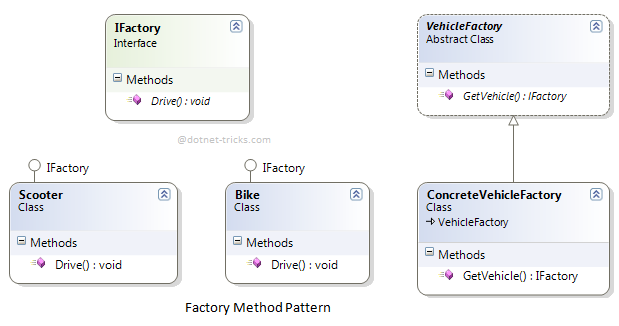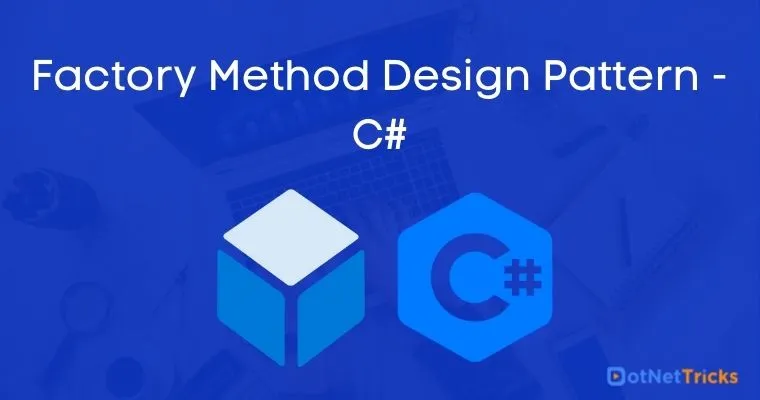25
AprFactory Method Design Pattern

⭐ .NET Design Patterns Course: Design Patterns in C# Online Training
Factory Method Design Pattern - C#: An Overview
The factory method design pattern abstracts the process of object creation and allows the object to be created at run-time when it is required. Factory method pattern falls under the Creational Pattern of Gang of Four (GOF) Design Patterns in .Net. It is used to create objects. People usually use this pattern as the standard way to create objects. In this Design Pattern Tutorial, I would like to share what is factory pattern and how it works.
What is the Factory Method Pattern?
In the Factory pattern, we create the object without exposing the creation logic. In this pattern, an interface is used for creating an object but lets the subclass decide which class to instantiate. The creation of an object is done when it is required. The Factory method allows a class later instantiation to subclasses.
Factory Method Pattern - UML Diagram & Implementation
The UML class diagram for the implementation of the factory method design pattern is given below:
The classes, interfaces, and objects in the above UML class diagram are as follows:
Product
This is an interface for creating the objects.
ConcreteProduct
This is a class that implements the Product interface.
Creator
This is an abstract class and declares the factory method, which returns an object of type Product.
ConcreteCreator
This is a class that implements the Creator class and overrides the factory method to return an instance of a ConcreteProduct.
C# - Implementation Code
interface Product
{
}
class ConcreteProductA : Product
{
}
class ConcreteProductB : Product
{
}
abstract class Creator
{
public abstract Product FactoryMethod(string type);
}
class ConcreteCreator : Creator
{
public override Product FactoryMethod(string type)
{
switch (type)
{
case "A": return new ConcreteProductA();
case "B": return new ConcreteProductB();
default: throw new ArgumentException("Invalid type", "type");
}
}
}This code demonstrates the Factory Method design pattern, in which a ConcreteCreator class determines which concrete Product type to construct based on input, separating object production from consumption.
Factory Method Pattern - Example

Who is what?
The classes, interfaces, and objects in the above class diagram can be identified as follows:
IFactory - Interface
Scooter & Bike - Create product classes
VehicleFactory - Creator
ConcreteVehicleFactory - Concreate Creator
C# - Sample Code
using System;
namespace Factory
{
/// <summary>
/// The 'Product' interface
/// </summary>
public interface IFactory
{
void Drive(int miles);
}
/// <summary>
/// A 'ConcreteProduct' class
/// </summary>
public class Scooter : IFactory
{
public void Drive(int miles)
{
Console.WriteLine("Drive the Scooter : " + miles.ToString() + "km");
}
}
/// <summary>
/// A 'ConcreteProduct' class
/// </summary>
public class Bike : IFactory
{
public void Drive(int miles)
{
Console.WriteLine("Drive the Bike : " + miles.ToString() + "km");
}
}
/// <summary>
/// The Creator Abstract Class
/// </summary>
public abstract class VehicleFactory
{
public abstract IFactory GetVehicle(string Vehicle);
}
/// <summary>
/// A 'ConcreteCreator' class
/// </summary>
public class ConcreteVehicleFactory : VehicleFactory
{
public override IFactory GetVehicle(string Vehicle)
{
switch (Vehicle)
{
case "Scooter":
return new Scooter();
case "Bike":
return new Bike();
default:
throw new ApplicationException(string.Format("Vehicle '{0}' cannot be created", Vehicle));
}
}
}
/// <summary>
/// Factory Pattern Demo
/// </summary>
class Program
{
static void Main(string[] args)
{
VehicleFactory factory = new ConcreteVehicleFactory();
IFactory scooter = factory.GetVehicle("Scooter");
scooter.Drive(10);
IFactory bike = factory.GetVehicle("Bike");
bike.Drive(20);
Console.ReadKey();
}
}
}This code includes a Vehicle Factory that wraps vehicle production, allowing clients to access alternative vehicles (scooters or Bikes) without knowing their specific classes, promoting flexibility and loose coupling.
Output

When to use it?
Subclasses figure out what objects should be created.
Parent class allows later instantiation to subclasses means the creation of an object is done when it is required.
The process of objects created is required to centralize within the application.
A class (creator) will not know what classes it will be required to create.
Summary
The factory method design pattern provides a flexible and centralized approach to object production. It separates clients from the creation process, allowing dynamic object instantiation based on runtime requirements. This pattern allows for clearer, more maintainable code and promotes loose coupling, making it an invaluable tool for developers.






